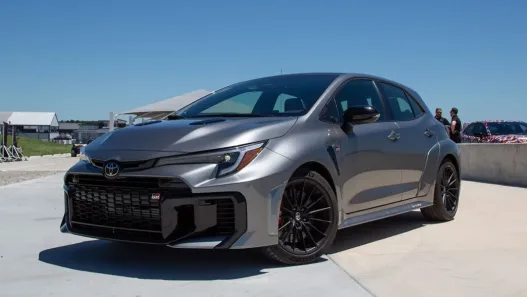Buick is one of the most historic and enduring names in the American automotive landscape. Founded in 1899 by automotive pioneer David Dunbar Buick, it played a pivotal role in shaping the early U.S. auto industry.
Buick was the cornerstone upon which General Motors (GM) was built in 1908, thanks in large part to the efforts of GM founder William C. Durant, who had previously served as Buick’s general manager and major investor.
With the discontinuation of Oldsmobile in 2004, Buick holds the distinction of being the oldest surviving American car brand.
Today, it occupies a premium position within GM’s portfolio, offering vehicles that bridge the gap between mainstream and luxury, sitting just below the upscale Cadillac division.
Buick Company History
1899
The first two Buick automobiles were built at the "Buick Auto-Vim and Power Company" by chief engineer Walter Marr.
1901
Walter Marr left the company due to David Buick's reluctance to enter automobile production and started an automobile firm under his own name.
1903
The third Buick automobile was built by Richard. David Buick officially incorporated the company as the Buick Motor Company on May 19 in Detroit, Michigan.
1905
Production ramped up under William C. Durant, who joined Buick as a controlling investor. That year saw 750 units produced, and the new Model C was launched.
1906
Buick produced 1,400 vehicles. David Buick sold his stock and left the company, becoming wealthy briefly but dying in modest circumstances 25 years later.
1907
Production reached 4,641 units. Buick agreed to supply motors to Canadian automaker R. S. McLaughlin. In the same year, Buick introduced its first full-size model, the Model D, powered by a four-cylinder 255 cu in T-head engine, one of the few Buick engines not using OHV technology.
1908
Buick produced 8,820 vehicles, surpassing Ford, Maxwell, and Oldsmobile to become the top-selling car brand in the U.S. Durant founded General Motors (GM), largely thanks to Buick’s success.
1910
Buick introduced the Model 10 with an overhead valve (OHV) four-cylinder engine. On November 15, General Motors' new leadership initiated a restructuring, leading to the phasing out of the Model 10.
1911
Buick launched its first closed-body car, the Buick Six, based on a bodystyle that first appeared at Cadillac, four years ahead of Ford. The car was manufactured at a new facility in Flint, which would later be known as Buick City.
1912
Buick truck production continued at the Jackson, Michigan, plant, which had operated since 1905.
1920
Buick produced various vehicle sizes during this decade, with model series designated by numbers in early years and letters in later years. One of the largest vehicles was the Buick Master Six, equipped with a straight-six engine.
1924
The Emperor of the Republic of China imported two Buicks, making them the first automobiles to enter China. Buick gained prestige in China during the 1910s and 1920s, often driven by or for high-level politicians.
1929
Buick launched the Marquette brand as part of GM’s companion make program, positioned between Buick and Oldsmobile. The Marquette featured a high-peaked hood, unique radiator shell styling, and suspension with four parallel semi-elliptical springs and Delco-Lovejoy shock absorbers.
1930
Marquette was discontinued after just one year on the market. By this year, Buick claimed one-sixth of all cars in China
1939
Buick became the first automaker to introduce turn signals. The feature did not become standard on other brands until nearly a decade later.
1948
Buick introduced the Dynaflow automatic transmission, the first mass-produced automatic transmission without gear shifts.
1949
Buick debuted the iconic “VentiPorts” on the front fenders of its vehicles, which became a distinctive design element.
1955
Buick recorded its best model year sales to date, with 738,814 vehicles sold—a record that would hold until 1977.
1959
Buick launched three new models: Electra, Invicta, and LeSabre. The Electra and Invicta featured a new 401 cubic inch V8 engine. An Electra also served as the pace car for the Indianapolis 500 that year.
1962
The Buick Special was named Motor Trend Car of the Year. Buick also introduced the Wildcat as a trim level on the Invicta.
1970
Buick introduced the Estate Wagon as its own standalone model, expanding its lineup of full-size vehicles.
1976
Buick began selling rebadged Isuzu Gemini models under the Opel name, replacing the German-built Opel Kadett it previously marketed.
1978
Celebrating its 75th anniversary, Buick introduced a redesigned Century and a new version of the Regal coupe, now available with a turbocharged V6 engine.
1979
The Riviera was redesigned with a more formal roofline and downsized dimensions. The Riviera S-Type variant was honored as Motor Trend Car of the Year.
1980
Lloyd Reuss was appointed as the general manager of Buick. He pushed Buick into turbocharging, racing, and high-performance production cars.
1984
Buick was the official car of the XXIII Olympiad. A corporate reorganization split manufacturing and engineering from sales and marketing. The first pilot car was produced at “Buick City” in Flint. Buick set another sales record with 906,626 U.S. vehicles sold and over one million units worldwide.
1988
Buick was the official car of the U.S. Olympic Team. The two-seat Reatta coupe debuted, and the Regal transitioned to front-wheel drive.
1989
The Park Avenue Ultra trim was added to the Electra. It carried a higher base price than Cadillac's Sedan de Ville.
1993
Buick celebrated its 90th anniversary by releasing a special edition LeSabre. This commemorative model included "90th Anniversary" badging, a cassette player, cruise control, rear-window defogger, power driver’s seat, carpeted floor mats, exterior pinstripes, and a choice of wire or aluminum wheel covers in addition to the standard Custom trim features.
1998
Buick relocated its headquarters from Flint to Detroit after 95 years. Bob Coletta, then Buick's general manager, witnessed the first Chinese-built Buick roll off the line in Shanghai before handing leadership to Roger Adams.
2000
Buick entered the new millennium with a redesigned LeSabre, continuing its streak as the best-selling full-size car in the U.S. for eight consecutive years.
2001
Buick made its first move into the crossover market by introducing the Rendezvous, which launched as a 2002 model.
2003
Buick celebrated its 100th anniversary with the Centieme concept crossover.
2005
Buick introduced the Terraza minivan, further expanding into family-oriented vehicles. GM began consolidating Buick, Pontiac, and GMC dealerships into a unified Buick-GMC network.
2010
Buick became the fastest-growing automotive brand in the U.S., attracting a younger demographic.
2018
Buick introduced an all-new Regal lineup, replacing the sedan with hatchback and station wagon variants. These were the first such body styles from Buick in North America since the 1987 Skyhawk (hatchback) and the 1996 Roadmaster (wagon).
2020
Buick introduced the Encore GX, a new subcompact crossover positioned between the existing Encore and Envision
2022
In June, Buick Global Chief Duncan Aldred announced the brand would transition to an all-electric lineup by 2030. Buick offered its dealers a buyout option instead of requiring them to invest in EV infrastructure upgrades.
2023
Buick launched the Envista, a new subcompact crossover for the 2024 model year.
2023
Chevrolet planned to enter the V8 Supercar Series with the Camaro, replacing the Holden ZB Commodore after existing contracts expired in 2022.
2025
Buick's North American lineup includes four crossovers: the Envista and Encore GX (subcompact), the Envision (compact), and the Enclave (mid-size).








